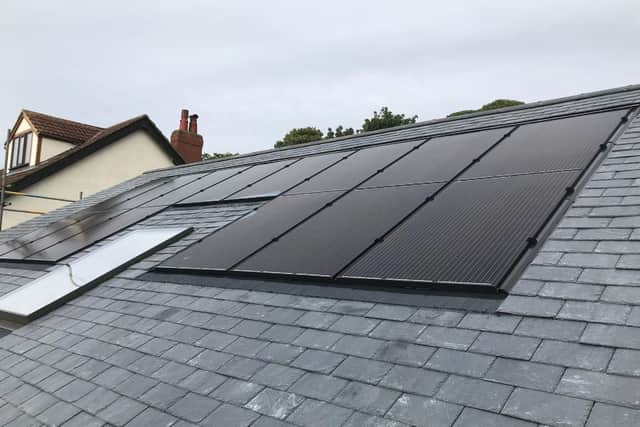With rapidly rising fuel prices electricity generating solar panels could be a good option for your home
Fuel price rises are a pressing concern at the moment. The Energy Saving Trust cites the current average price of electricity as 20.06p/kWh and this is set to rise when the energy price cap increases in April. This will hit hardest in the autumn and winter and has led to renewed interest in renewable sources of energy in general and in particular solar photovoltaic panels, which generate electricity from the sun’s rays.
John Gilham, technical director of Yorkshire-based Green Building Renewables says: “For those with savings in the bank, investing in a solar PV system and battery storage system, with an initial outlay of around £7,500 would pay back over a number of years through reduced electricity bills.
Advertisement
Hide AdAdvertisement
Hide Ad“How rapid the payback would be and how much money is saved partly depends on how the system is used and occupant behaviour. The Energy Savings Trust’s calculator can help estimate potential financial savings. If fuel bills continue their alarming trajectory, the payback period could be quicker. If you also factor in a VAT rate of 5 per cent for solar PV and the low interest rates offered by banks, then the finances of solar PV really begin to stack up.” Here, John answers some questions on the subject:


*Are all homes suitable for solar PV? It is suitable for around 95 per cent of all homes. It can be installed in a range of places and not necessarily just south-facing roofs. So long as the roof is not shaded, solar PV is suitable for apex and flat roofs and even fields. It is easy and quick to install and requires minimal maintenance.
*How does solar PV work? Solar photovoltaic panels convert light into electricity. Each panel is made up of numerous silicon cells, which create an electrical flow once the sunlight activates the electrons. An inverter converts the energy from DC to AC current to make it useable in the home and then takes this by cable to the electricity consumer unit. This electricity is then available for the home’s immediate electricity use or it can be stored in a solar battery or exported to the grid if not needed.
Do the panels work in winter? Solar Panels will work 365 days of the year. The highest solar gain is in the summer months when we have longer, brighter days. Even in winter months, on a bright clear day, you will still generate a significant amount of solar gain.
Advertisement
Hide AdAdvertisement
Hide AdHow do you make solar PV work harder? Ten to twelve solar PV panels might cost around £4,000 and then adding a solar battery another £3,500 on top of that. Solar batteries help you get the most out of your solar PV system. The advantage of having a battery with is that the energy created during the day can be stored and used at night when the sun isn’t shining, helping cut fuel bills further. The bigger capacity that the Tesla solar batteries gives you means there is an additional advantage of providing energy to your home during a power cut.
Can you heat water with a solar PV system? For a small additional upgrade, any excess energy produced by a solar PV panel can be diverted to power a domestic hot water immersion heater. This means that during months of April to September, the solar PV can be powering your hot water as well, bypassing the need for separate “solar thermal” panels.
What about powering air source heat pumps? Solar PV is often chosen alongside heat pump technology as it offers an excellent low carbon heating combination, making keeping your house warm cheaper and less reliant on fossil fuels.
How does exporting to the grid work? Nearly all solar PV systems are tied to the grid, so your system can export the excess energy you don’t use or don’t store, thanks to the Smart Export Guarantee. However, the price you are paid for this is lower than the cost you pay to import electricity, so storing the energy in a solar battery would probably make more financial sense in the long run.
Advertisement
Hide AdAdvertisement
Hide AdCase study: Climate concerns and a bid to reduce carbon emissions led to a solar PV and air source heat pump system in a detached house in York. Green Building Renewables installed 14 solar PV panels of 320W capacity to the roof, which faces east and west. The electricity generated is used to power the electricity needs of the home, including the heat pump, with excess diverted to heat the hot water or exported to the grid.
Retired homeowner Mr Floyd says: “It looks like I’m getting around a 10 per cent return on my overall investment, which is a lot more than I’d be getting if the money was sitting in the bank, with the added bonus of having substantially reduced the carbon footprint of the house.” In summer 2021, the four-bedroom house drew an average of 9kW hours a day from the grid, exported 398kW hours to the grid as well as providing off grid energy during daylight hours to heat hot water and for cooking, leaving an electricity bill of just £12.39 for a month.
www.greenbuildingrenewables.co.uk.
Please support The Yorkshire Post and become a subscriber today. Your subscription will help us to continue to bring quality news to the people of Yorkshire. In return, you'll see fewer ads on site, get free access to our app and receive exclusive members-only offers. Click here to subscribe